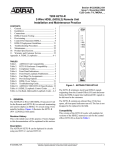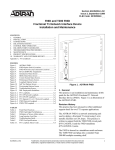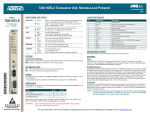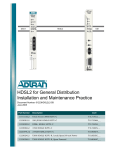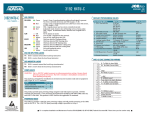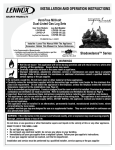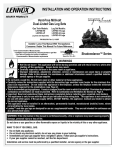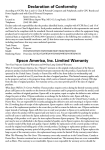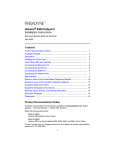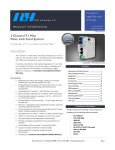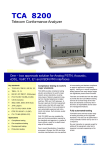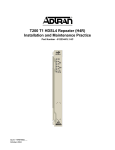Download ADTRAN HDSL4 Specifications
Transcript
Section 61223424L2-5A Issue 1, December 2003 CLEI Code: T1L497PC_ _ HDSL4 T200 H4TU-R Installation and Maintenance Practice CONTENTS 1. General...................................................................................... 1 2. Installation ................................................................................ 2 3. Connections .............................................................................. 5 4. HDSL4 System Testing ............................................................ 5 5. Front Panel Operation............................................................... 7 6. Control Port Operation.............................................................. 7 7. HDSL4 Deployment Guidelines............................................. 18 8. Maintenance............................................................................ 23 9. Specifications.......................................................................... 23 10. Warranty and Customer Service ............................................. 23 Appendix A. HDSL4 Loopbacks.............................................. A-1 1223424L2 LOCAL DSL 1 DSL 2 DS1 ALM ESF/ SF (YEL) (GRN) B8ZS/ AMI (YEL) (GRN) LLB / RLB (YEL) (GRN) TABLES Table 1. ADTRAN Unit Compatability........................................ 1 Table 2. H2TU-R Enclosure Compatibility .................................. 2 Table 3. Compliance Codes .......................................................... 2 Table 4. Front Panel Indicators..................................................... 3 Table 5. Provisioning Options ...................................................... 4 Table 6. Attenuation limits ......................................................... 18 Table 7. Range Limits: 26 Gauge / 70°F / PIC .......................... 18 Table 8. Range Limits: 24 Gauge / 70°F / PIC .......................... 18 Table 9. Single Pair DC Resistance Value.................................. 19 Table 10. HDSL4 Insertion Loss Values ...................................... 22 Table 11. Single Span and First Segment of Repeatered Loop .... 22 Table 12. Second or Third Segment of Repeatered Loop............. 22 Table 13. Troubleshooting Guide ................................................. 23 Table 14. HDSL4 T200 H4TU-R Specifications.......................... 24 Table A-1. HDSL4 Loopback Control Codes............................ A-2 Table A-2. Loopback Control Codes ......................................... A-3 1. GENERAL The ADTRAN 4-wire T200 HDSL4 transceiver unit for the remote end (H4TU-R), P/N 1223424L2, is a network terminating unit used to deploy an HDSL4 T1 circuit using 4-wire metallic facilities. See Figure 1. This version of the H4TU-R works with multiple list versions of the HDSL4 transceiver unit for the central office (H4TU-C) and repeater (H4R) as listed in Table 1. Revision History This is the initial release of this document. Future revisions to this document will be explained in this subsection. LOC REM TX M O N RX LBK TX RX R S 2 3 2 Figure 1. ADTRAN HDSL4 T200 H4TU-R Table 1. ADTRAN Unit Compatability Unit Number Description 122x401L1 or L2 220 H4TU-C 122x403L1 or L2 DDM+ H4TU-C 122x404L1 or L2 3192 H4TU-R 118141xL1 Total Access H4TU-C 122x441L1 T200 H4R 122x445L1 239 H4R NOTE: x = any generic release number 61223424L2-5A Trademarks: Any brand names and product names included in this document are trademarks, registered trademarks, or trade names of their respective holders. 1 Description The T200 H4TU-R can be deployed in circuits using one H4TU-C, one H4TU-R, and up to two H4Rs. The T200 H4TU-R terminates local loop HDSL4 signals originating from the Central Office (CO) unit and transforms the HDSL4 signal into traditional DS1 signals to be delivered to the customer. The T200 H4TU-R can be used with any H4TU-C to complete an HDSL4 circuit with up to two H4Rs. Local power is provided through the enclosure. NOTE This unit is intended for Local Power Only. If a span powered unit is needed, refer to P/N 122x426L2. The H4TU-R is a T200 mechanics card which will fit Type 200 or Type 400 mechanics enclosures, as listed in Table 2. This table also provides reference information on the ADTRAN enclosures. Table 2. H4TU-R Enclosure Compatibility Part Number Description1 Document Number 1242007Lx HR12 Metal Enclosure Remote Shelf 61242007LX-5x 1242008L1 HR4 Installation/ Maintenance 61242008L1-5 1242034L2 T400 Single Mount (removable RJ-48 jacks) 61242034L2-5 1242034L3 T400 Single-Mount High Voltage Enclosure 61242034L3-5 1245034L12 T200 Dual-Mount Installation/ Maintenance 61245034L1-5 This product meets all requirements of Bellcore GR1089-CORE (Class A2), ANSI T1.418-2002 and is NRTL listed to the applicable UL standards. Table 3. Compliance Codes Code Input Output Power Code (PC) C C Telecommunication Code (TC) X X Installation Code (IC) A – 2. INSTALLATION After unpacking the unit, inspect it for damage. If damage is discovered, file a claim with the carrier, then contact ADTRAN. Refer to the Warranty and Customer Service section in this practice. The settings on the H4TU-C are encoded and transmitted to the T200 H4TU-R once the circuit has achieved synchronization. There are no switch settings on the T200 H4TU-R. To install the T200 H4TU-R, perform the following steps: 1. If present, remove the Access Module Blank from the appropriate access module slot of the enclosure. 2. Hold the T200 H4TU-R by the front panel while supporting the bottom edge of the module. 3. Align the module edges to fit in the lower and upper guide grooves for the module slot. 4. Slide the module into the slot. Simultaneous thumb pressure at the top and at the bottom of the module will ensure that the module is firmly seated against the backplane of the enclosure. WARNING 1 In all applications the H4TU-R must be installed in NEBS compliant and UL listed enclosures to insure full compliance with this unit. 2 ADTRAN’s T200 Dual-Mount housing (P/N 1245034L1) is required when using the T200 H4TU-R for HDSL Loop Support System (H-LSSTM) protection circuits. 2 Compliance Table 3 shows the compliance codes for the T200 H4TU-R. This product is intended for installation in equipment with a Type “B” or “E” enclosure. Up to –200 VDC may be present on telecommunications wiring. Ensure chassis ground is properly connected. Issue 1, December 2003 61223424L2-5A Front Panel LED Indicators There are seven front panel mounted status LED indicators. Each indicator is described in Table 4. Table 4. Front Panel LED Indicators Front Panel Name Indication Description DSL 1 Green DSL Loop 1 sync, no errors currently detected, and signal margin ≥3dB Red No DSL Loop 1 sync, errors being detected, or signal margin <3dB Green DSL Loop 2 sync, no errors currently detected, and signal margin ≥3dB Red No DSL Loop 2 sync, errors being detected, or signal margin <3dB Green DS1 signal is present and no errors currently being detected Red No DS1 signal or signal is present with errors OFF No active alarm present Red Loss of DS1 signal to the unit Yellow Loss of DSX-1 signal to the H4TU-C OFF Unit is provisioned for UNFRAMED data Yellow Unit is provisioned for ESF data Green Unit is provisioned for SF data Yellow Unit is provisioned for B8ZS coded data Green Unit is provisioned for AMI data OFF Unit is NOT in loopback Yellow Unit is in loopback (network and/or customer) Green H4TU-C is in loopback toward this unit 1223424L2 LOCAL DSL 1 DSL 2 DSL 2 DS1 ALM ESF/ SF (YEL) (GRN) DS1 B8ZS/ AMI (YEL) (GRN) LLB / RLB (YEL) (GRN) ALM LOC REM LBK ESF/SF TX M O N RX TX RX B8ZS/AMI R S 2 3 2 LLB/RLB 61223424L2-5A Issue 1, December 2003 3 Remote Provisioning There are no configuration switches for the T200 H4TU-R. Configuration is performed via software discussed in the Control Port Operation section of this practice. The provisioning settings can be viewed and manipulated through management access via the front panel RS-232 port. Table 5 lists the available provisioning options and their factory default settings. Table 5. Provisioning Options Provisioning Option Option Settings Default Settings 1. DSX-1 Line Build Out 0-133 ft., 133-266 ft., 266-399 ft., 399-533 ft., 533-655 ft. 0 to 133 ft. 2. DSX-1/DS1 Line Code B8ZS, AMI B8ZS 3. DSX-1/DS1 Framing SF, ESF, Unframed, Auto ESF 4. Force Frame Conversion 1 Disabled, Enabled Disabled 5. Smartjack Loopback Disabled, Enabled Enabled 6. Loopback Time Out None, 120 Min 120 Minutes 7. Latching Loopback Mode 2 T1 (Disabled), FT1 (Enabled) T1 (Disabled) 8. DS1 Tx Level 0 dB, -7.5 dB, -15 dB 0 dB 9. Customer Loss Indicator 3 AIS, Loopback, AIS/CI AIS/CI 11. Performance Reporting Messages None, SPRM, NPRM, AUTO (both) AUTO 12. Loop Attenuation Alarm Threshold 0 (Disabled), 1-99 dB 34 dB 13. SNR Margin Alarm Threshold 0 (Disabled), 1-15 dB 04 dB 14. Remote Provisioning Disabled, Enabled Enabled 1 The forced frame format conversion (FFFC) mode sets the H2TU-C to ESF and the H2TU-R to SF. This mode should be used to force SF (DS1 from customer) to ESF (DSX-1 to network) conversion in the absence of network-provided ESF framing. 2 Latching Loopback Mode • T1 — When optioned for T1 mode, the unit does not respond to DDS Latching Loopback codes. • FT1 — DDS Latching Loopback operation is supported. The H4TU-C and any H4R units which are in the HDSL circuit are treated as identical Tandem Data ports and the HTU-R is treated as a different Tandem Data port. NOTE: When operating in FT1 mode and during periods of T1 loss of signal, LOS, or T1 AIS from the customer CI, the HDSL system will send in the network direction from the HTU-C a Fractional DS1 idle signal consisting of a repeating 7E (HEX) byte payload within a framed/unframed T1 signal. In addition, when optioned for FT1 mode, the setting for Customer Loss Response is ignored. 3 Customer Loss Indicator • AIS — Send AIS to network upon T1 loss of signal or T1 AIS from customer. • LPBK — HTU-R initiates a network loopback upon T1 loss of signal or T1 AIS from customer. • AIS/CI — HTU-R sends customer disconnect indication upon loss of signal, loss of synchronization, or receipt of T1 AIS from customer. NOTE: The CI is generated by transmitting the framing received from the network while overwriting the payload with a repeating pattern. For applications where the DS1 is Extended Superframe, the data link is overwritten with a Yellow Alarm that is interrupted once every second by a 100 milli-second code burst of 7E (HEX). 4 Issue 1, December 2003 61223424L2-5A 3. CONNECTIONS All connections of the T200 H4TU-R are made through card edge connectors. Figure 2 gives the card edge pin assignments for the T200 H4TU-R circuit pack. 1 2 3 4 5 6 7 8 9 10 11 12 13 14 15 16 17 18 19 20 21 22 23 24 25 26 27 28 29 30 31 32 33 34 35 36 37 38 39 40 41 42 43 44 45 46 47 48 49 50 51 52 53 54 55 Chassis Ground 4. HDSL4 SYSTEM TESTING The T200 H4TU-R provides diagnostic, loopback, and signal monitoring capabilities. The seven front panel LEDs provide diagnostics for HDSL4 loops, DS1 signals, alarms, provisioning, and loopbacks. Refer to the Installation section for details. The H4TU-R provides a bidirectional loopback via the loopback button on the front panel. Refer to the H4TU-R Network Loopbacks and Customer Loopbacks sections for more details. DS1 TX Tip HDSL4 Tip Loop 1 DS1 MON Bantam Jacks The MON jack provides a non intrusive access point for monitoring the characteristics of the transmit and receive signals at the DS1 interface point. Chassis Ground HDSL4 Ring Loop 1 DS1 TX Ring For example, the DS1 MON jack on the H4TU-R could be used to connect to a bit error rate tester to monitor for synchronization, test patterns, etc. –24 V/-48 V Return Figure 3 is an illustration of specific jack detail. NOTE Chassis Ground For the MON jacks, the TX and RX indications relate to the direction of the signal to/from the CPE. –24 VDC/-48 VDC H4TU-R HDSL4 Tip Loop 2 T R TX DS1 MON HDSL4 Ring Loop 2 DS1 RX Ring CPE DS1 INTERFACE RX T1 R1 DS1 RX Tip Figure 2. H4TU-R Edge Connector Wiring Figure 3. H4TU-R MON Diagram CAUTION Ensure chassis ground is properly connected for either standalone or shelf-mounted applications. 61223424L2-5A Issue 1, December 2003 5 H4TU-R Network Loopbacks The loopback position is a logic loopback located within the H4TU-R internal HDSL4 transceiver. See Figure 4. H4TU-C Network-Side Loopback AIS LOCAL LOOP DSX-1 DS1 X H4TU-R H4TU-C H4TU-R Network-Side Loopback and/or H4TU-R NIU Loopback AIS LOCAL LOOP DSX-1 DS1 X H4TU-C H4TU-R H4TU-R Customer-Side Loopback X LOCAL LOOP DSX-1 AIS DS1 H4TU-C H4TU-R H4TU-C Customer-Side Loopback X LOCAL LOOP DSX-1 AIS DS1 H4TU-C H4TU-R H4R Network-Side Loopback DS1 H4TU-C X H4TU-R H4R • First, manual loopback on the H4TU-R and/or the H4TU-C unit may be controlled from the front panel. Refer to the Front Panel Operation section of this practice for more detail. • Second, loopback activation may be accomplished using the control port of the H4TU-R. • Third, the H4TU-R will respond to the industry standard HDSL loopback codes as designated in the ANSI document T1E1.4/92. These are described in Appendix A, HDSL4 Loopbacks. • Fourth, the H4TU-R responds to T1 Network Interface Unit (NIU) loopback codes as described in Bellcore TR-TSY-000312, as follows: In-Band Codes Loop up 11000 (2 in 5) Loop down 11100 (3 in 5) ESF Codes Loop up 1111 1111 0100 1000 (FF 48) Loop down 1111 1111 0010 0100 (FF 24) Receiving the in-band codes for more than five seconds or the ESF codes four consecutive times will cause the appropriate loopback action. The ESF codes must be transmitted in the Facility Data Link (FDL). AIS DSX-1 The H4TU-R responds to multiple loopback activation processes: H4R Customer-Side Loopback X DSX-1 AIS NOTE DS1 H4TU-C H4R H4TU-R H4R1 Network-Side Loopback AIS DSX-1 The NIU loopback option must be enabled before the H4TU-R can respond to the NIU loopback. DS1 H4TU-C H4R1 H4R2 X H4TU-R H4R1 Customer-Side Loopback X DSX-1 DS1 H4TU-C AIS H4R1 H4R2 H4TU-R The H4TU-R will respond to the loopback codes by activating the NIU loopback from either the disarmed or armed state. The loop down codes will return the H4TU-R to the disarmed or de-activated state depending upon the code utilized. H4R2 Network-Side Loopback AIS DSX-1 DS1 H4TU-C H4R1 H4R2 X H4TU-R H4R2 H4TU-R H4R2 Customer-Side Loopback X DSX-1 AIS DS1 H4TU-C H4R1 X = Signal Inactive Figure 4. HDSL4 Loopbacks 6 Customer Loopbacks In addition to the loopbacks in the direction of the network, the H4TU-R may also be looped back in the direction of the customer. The H4TU-C and H4TU-R Customer Side Loopbacks are illustrated in Figure 4. NOTE Network and customer loopbacks are governed by the loopback time out option (Default=120 minutes). Issue 1, December 2003 61223424L2-5A 5. FRONT PANEL OPERATION The front panel contains two pushbuttons. These are labeled LOC and REM. The LOC pushbutton controls a bidirectional loopback at the H4TU-R. Pressing the button causes a bidirectional loopback to occur. If the bidirectional loopback is active, pressing the button a second time will disable the loopback. The REM pushbutton controls a bidirectional loopback at the H4TU-C. Pressing the button causes a loopback toward the H4TU-R and network to occur. If the loopback is active, pressing the button a second time will disable the loopback. 6. CONTROL PORT OPERATION The H4TU-R provides a front panel-mounted DB-9 connector that supplies an RS-232 interface for connection to a controlling terminal. The pinout of the DB-9 is illustrated in Figure 5. 6 7 8 9 1 2 TXD (Transmit Data) 3 RXD (Receive Data) NOTE If a personal computer with terminal emulation capability is being used, be sure to disable any power-saving programs. Otherwise, communication between the PC and the HDSL4 unit may be disrupted, resulting in misplaced characters or screen time outs. Operation The screens illustrated in the following section apply to an HDSL4 circuit deployed with the ADTRAN HDSL4 technology. The circuit includes an H4TU-C, up to two H4Rs and an H4TU-R. Other configurations are possible (such as use of another vendor's equipment) and their displays will vary slightly from those shown in this section. A terminal session is initiated by entering multiple spacebar characters which are used by the H4TU-R to determine the speed of the terminal. Once the speed has been determined, an HDSL4 Main Menu is presented as illustrated in Figure 6. 4 5 SGN (Signal Ground) Figure 5. RS-232 (DB-9) Connector Pinout The terminal interface operates at data rates from 1.2, 2.4, 4.8, 9.6, and 19.2 kbps. The asynchronous data format is fixed at 8 data bits, no parity, and 1 stop bit. 61223424L2-5A Issue 1, December 2003 7 This ADTRAN HDSL4 Main Menu provides access to detailed performance and configuration information. The OAM&P (Operation, Administration, Maintenance, and Provisioning) screens are available as listed on the Main Menu (Figure 6). To access a particular menu item, press the number associated with that item, and press ENTER. The HDSL4 Unit Information Screen (Figure 7) provides detailed product information on each component in the HDSL4 circuit. This screen also displays contact information for ADTRAN Technical Support, Internet site, and address. Circuit ID: 10/01/03 09:29:45 Adtran HDSL4 Main Menu 1. 2. 3. 4. 5. 6. 7. 8. 9. 10. 11. 12. 13. HDSL4 Unit Information Provisioning Span Status Loopbacks and Test Performance History Scratch Pad, Ckt ID, Time/Date Terminal Modes Alarm History Event History System PM/Screen Report Clear PM and Alarm Histories Troubleshooting Virtual Terminal Control Selection: Figure 6. HDSL4 Main Menu Circuit ID: 10/01/03 09:29:45 Press ESC to return to previous menu ADTRAN 901 Explorer Boulevard Huntsville, Alabama 35806-2807 --------------------- For Information or Technical Support --------------------Support Hours ( Normal 7am - 7pm CST, Emergency 7 days x 24 hours ) Phone: 800.726.8663 / 888.873.HDSL Fax: 256.963.6217 Internet: www.adtran.com -------------------------------------------------------------------------------ADTN P/N: S/N: CLEI: Manf: Ver: H4TU-C 1223403L2 123456789 T1L7PODAAA 01/01/2000 A00 ADTN P/N: S/N: CLEI: Manf: Ver: H4TU-R 1223424L2 123456789 T1L497PCAA 01/01/2000 A01 ADTN P/N: S/N: CLEI: Manf: Ver: H4R1 1221445L1 BB50A8343 T1R5YP3DAA 02/12/2002 A01 ADTN P/N: S/N: CLEI: Manf: Ver: H4R2 1221445L1 BB50A8353 T1R5YP3DAA 02/12/2002 A01 Figure 7. Unit Information Screen 8 Issue 1, December 2003 61223424L2-5A The Provisioning menu (Figure 8) displays current provisioning settings for the HDSL4 circuit. Options that can be changed from this screen are labeled with a number (for example, “1” for DSX-1 Line Build Out). To change a particular option setting, select the appropriate number, and a new menu will appear with a list of the available settings. The options shown in Table 5 are available with the T200 H4TU-R (P/N 1223426L2). Some settings may differ when using different H4TU-Rs. The Span Status Screen (Figure 9) provides quick access to status information for each HDSL4 receiver in the circuit. Circuit ID: 10/01/03 09:29:45 Press ESC to return to previous menu Provisioning 1. 2. 3. 4. 5. 6. 7. 8. 9. 10. 11. 12. 13. 14. D. DSX-1 Line Buildout = DSX-1/DS1 Line Code = DSX-1/DS1 Framing = Forced Frame Conversion = Smartjack Loopback = Loopback Timeout = Latching Loopback Mode = DS1 TX Level = Span Power = Customer Loss Indicator = PRM Setting = Loop Atten Alarm Thres = SNR Margin Alarm Thres = Remote Provisioning = Restore Factory Defaults 0-133 ft B8ZS ESF Disabled Enabled 120 Min T1 (Disabled) 0 dB Enabled AIS/CI AUTO 34dB 04dB Enabled Selection: Figure 8. Provisioning Menu Circuit ID: 10/01/03 09:29:45 Press ESC to return to previous menu Span Status Screen ______ ______ ______ ______ | | | | | | | | CUST | | | | | | | | ----->| |-------| |-------| |----------------------| |-----> | | | | | | | | | | | | | | | | <-----| |-------| |-------| |----------------------| |<----| | | | | | | | DSX-1 |______| |______| |______| |______| DS1 H4TUC H4R 1 H4R 2 H4TUR NET 1. View Detailed Status Selection: Figure 9. Span Status Screen 61223424L2-5A Issue 1, December 2003 9 Each HDSL4 circuit component can be looped toward the network or customer from this screen. Unit self tests can also be initiated from this screen. The Detailed Status Screen from the Span Status menu (Figure 10), displays the HDSL4 status for each receiver point. The Loopbacks and Test Commands menu (Figure 11) provides the ability to invoke or terminate all available HDSL4 loopbacks. Circuit ID: 10/01/03 09:29:45 Press ESC to return to previous menu Detailed Status Screen LOOP 1 MARGIN ATTEN (CUR/MIN/MAX) (CUR/MAX) ------------- --------17/00/17 00/00 17/00/17 00/00 17/17/17 00/00 17/00/17 00/00 17/17/17 00/00 17/00/17 00/00 Interface --------H4TUC H4R1 NETW H4R1 CUST H4R2 NETW H4R2 CUST H4TUR LOOP 2 MARGIN ATTEN (CUR/MIN/MAX) (CUR/MAX) ------------- --------17/00/17 00/00 17/13/17 00/00 17/00/17 00/00 17/13/17 00/00 17/00/17 00/00 17/00/17 00/00 1. Reset Min/Max 2. View Performance History Selection: Figure 10. Detailed Status Screen Circuit ID: 10/01/03 09:29:45 Press ESC to return to previous menu Loopbacks and Test Commands ______ ______ ______ ______ | | | | | | | | CUST | | | | | | | | ----->| |-------| |-------| |----------------------| |-----> | | | | | | | | | | | | | | | | <-----| |-------| |-------| |----------------------| |<----| | | | | | | | DSX-1 |______| |______| |______| |______| DS1 H4TUC H4R 1 H4R 2 H4TUR NET 1. 2. 3. 4. 5. 6. Run Self Tests H4TU-C Loopup Net H4TU-C Loopup Cust H4TU-R Loopup Net H4TU-R Loopup Cust H4R1 Loopup Net 7. 8. 9. H4R1 H4R1 H4R2 Loopup Loopup Loopup Cust Net Cust Selection: Figure 11. Loopbacks and Test Commands Menu 10 Issue 1, December 2003 61223424L2-5A The Performance History screens (Figure 12 and Figure 13) are used to select and display the historical HDSL4 and T1 performance data in several different registers. At each 15-minute interval, the performance information is transferred to the 15-minute performance data register. This unit stores performance data in 15- minute increments for the previous 24-hour period. At each 24-hour interval, the performance data is transferred into the 24-hour performance data registers. This unit stores up to 31 days of 24-hour interval data. Line Data or Path Data results are available by selecting the appropriate menu item. Circuit ID: 10/01/03 09:29:45 Press ESC to return to previous menu Menu 1. 2. 3. 4. 5. 6. 7. 8. 9. 10. 11. 12. 13. 14. 15. 15 Minute H4TUC DSX-1 Performance Data Definitions Reset Data 15 Min Data 60 Min Data 24 Hr Data Line Data Path Data H4TUC DSX-1 H4TUR LOOP H4TUR LOOP H4TUR DS1 H4R #1 NETW H4R #1 CUST H4R #2 NETW H4R #2 CUST 14:15 14:00 13:45 13:30 13:15 13:00 12:45 12:30 ES-L 000 000 000 000 000 000 000 000 000 SES-L 000 000 000 000 000 000 000 000 000 LOSS-L 000 000 000 000 000 000 000 000 000 CV-L 00000 00000 00000 00000 00000 00000 00000 00000 00000 ___ ___ ___ ___ | C | |#1 | |#2 | | R | -8->| |-----| |-----| |---------------| |---> | |9 12| |13 14| |15 10| | <---| |-----| |-----| |---------------| |<-11 |___| |___| |___| |___| Selection: Figure 12. 15-Minute Performance Data Screen Circuit ID: 10/01/03 09:29:45 Press ESC to return to previous menu Menu 1. 2. 3. 4. 5. 6. 7. 8. 9. 10. 11. 12. 13. 14. 15. Definitions Reset Data 15 Min Data 60 Min Data 24 Hr Data Line Data Path Data H4TUC DSX-1 H4TUC LOOP H4TUR LOOP H4TUR DS1 H4R #1 CUST H4R #1 CUS H4R #2 NETW H4R #2 CUST 10/17 10/16 10/15 10/14 10/13 10/12 10/11 24 Hour H4TUC LOOP Performance Data LOOP 1 LOOP 2 ES-L SES-L UAS-L ES-L SES-L UAS-L 00000 00000 00000 00000 00000 00000 ----- ----- ----- ----- ----- --------- ----- ----- ----- ----- --------- ----- ----- ----- ----- --------- ----- ----- ----- ----- --------- ----- ----- ----- ----- --------- ----- ----- ----- ----- --------- ----- ----- ----- ----- ----- ___ ___ ___ ___ | C | |#1 | |#2 | | R | -8->| |-----| |-----| |---------------| |---> | |9 12| |13 14| |15 10| | <---| |-----| |-----| |---------------| |<-11 |___| |___| |___| |___| Selection: Figure 13. 24-Hour Performance Data Screen 61223424L2-5A Issue 1, December 2003 11 Abbreviations used in the Performance History screens are defined in Performance Data Definitions screens (Figure 14 and Figure 15). Line related definitions are shown in Figure 14 while Path related definitions are provided in Figure 15. Circuit ID: 10/01/03 09:29:45 Performance Data Definitions H4TUC, H4TUR, and H4R LOOP Related: ES-L Errored Seconds SES-L Severely Errored Seconds UAS-L Unavailable Seconds HDSL4 Framing CRC>=1 or LOSW>=1 CRC>=50 or LOSW>=1 >10 cont. SES-Ls DS1 and DSX-1 Line Related: ES-L Errored Seconds SES-L Severely Errored Seconds LOSS-L Loss of Signal Seconds PDVS-L Pulse Density Violation Secs B8ZS-L B8ZS Seconds CV-L Code Violation Count Superframe and Extended Superframe (BPV+EXZ)>=1 or LOS>= 1 (BPV+EXZ)>=1544 or LOS>=1 LOS>= 1 EXZ>=1; >7 zeros if B8ZS, >15 if AMI B8ZS coded signal received (BPV+EXZ) count NOTE: Reverse video indicates invalid data due to a terminal restart (or power cycle), a data register reset, or a system date or time change. N. P. Next Previous Selection: Figure 14. Performance Data Definitions Circuit ID: 10/01/03 09:29:45 Performance Data Definitions DS1 and DSX-1 Path Related: ES-P Errored Seconds SES-P Severely Errored Seconds UAS-P SAS-P ES-PFE Unavailable Seconds SEF/AIS Seconds Far End Errored Seconds CV-P Code Violation Count Superframe FE>=1 or SEF>=1 or AIS>=1 FE>=8 or SEF>=1 or AIS>=1 >10 cont. SES-Ps SEF>=1 or AIS>=1 n/a FE count Extended Superframe CRC>=1 or SEF>=1 or AIS>=1 CRC>=320 or SEF>=1 or AIS>=1 >10 cont. SES-Ps SEF>=1 or AIS>=1 PRM bits G1-G6,SE, or SL=1, or RAI CRC error count NOTE: Under a UAS-P condition, ES-P and SES-P counts are inhibited. Under a SES-L or SES-P condition, the respective CV-L or CV-P count is inhibited. P. Previous Selection: Figure 15. Performance Data Definitions (Continued) 12 Issue 1, December 2003 61223424L2-5A The Scratch Pad, Circuit ID, and Time/Date Screen (Figure 16) provides a Scratch Pad for user-defined information and can be any alphanumeric string up to 50 characters in length. The Circuit ID can be any alphanumeric string up to 25 characters in length. The time should be entered using military time. (For example, enter 3:15 p.m. as “151500”.) The date should be entered in the MMDDYY format. (For example, enter January 02, 2003, as “010203”.) The T1 Alarm History menu (Figure 17) and HDSL4 Span History menu (Figure 18) provide a detailed alarm history and events log for the HDSL4 and T1 spans. These screens include a time, date, first and last occurrence, and count for each type of HDSL4 or T1 alarm. A historical alarm log is also available in the System Alarm menu. Circuit ID: 10/01/03 09:29:45 Current Scratch Pad: New Scratch Pad = New Circuit ID = New Date = New Time = / : / : (MM/DD/YY) (HH:MM:SS) Press TAB to skip to next entry field. Figure 16. Scratch Pad, Circuit ID, and Time/Date Screen Circuit ID: Press ESC to return to previous menu 10/01/03 09:29:45 T1 Alarm History LOCATION ALARM FIRST LAST CURRENT COUNT -----------------------------------------------------------------------------H4TU-C (DSX-1) H4TU-R (DS1) RED(LOS/LOF) 01/01/00 YELLOW(RAI) BLUE(AIS) RED(LOS/LOF) 06/01/03 YELLOW(RAI) BLUE(AIS) 00:00:05 01/01/00 23:46:22 06/01/03 00:00:05 Alarm OK OK 23:46:22 Alarm OK OK 001 000 000 001 000 000 -----------------------------------------------------------------------------1. T1 Alarm 4. Span H4R1 to H4R2 2. Facility Alarm 5. Span H4R2 to H4TU-R 3. Span H4TUC to H4R1 C. Clear T1 Alarms Figure 17. T1 Alarm History Menu 61223424L2-5A Issue 1, December 2003 13 The Event History screen (Figure 19) provides a log history of HDSL4 circuit events. Circuit ID: 10/01/03 09:29:45 Press ESC to return to previous menu HDSL4 Span History LOCATION ALARM FIRST LAST CURRENT COUNT ----------------------------------------------------------------------------SPAN C-H1 L1 LOS OK 000 L2 LOS OK 000 H4TU-C H4R1 NET H4TU-C H4R1 NET L1 L2 L1 L2 MRGN MRGN MRGN MRGN OK OK OK OK 000 000 000 000 L1 L2 L1 L2 ATTEN ATTEN ATTEN ATTEN OK OK OK OK 000 000 000 000 -------------------------------------------------------------------------------1. T1 Alarm 4. Span H4R1 to H4R2 2. Facility Alarm 5. Span H4R2 to H4TU-R 3. Span H4TUC to H4R1 C. Clear Span Alarms Selection: Figure 18. HDSL4 Span History Screen Circuit ID: 10/01/03 09:29:45 Press ESC to return to previous menu Num Description of Event Date Time ----------------------------------------------------------------1. H4TU-C Powered Up 01/25/02 11:52:00 Page Number: 1/ 1 Number of Events: 1 ----------------------------------------------------------------'P' - Previous Page 'H' - Home 'R' - Reset Events 'N' - Next Page 'E' - End Selection: Figure 19. Event History Screen 14 Issue 1, December 2003 61223424L2-5A The System PM/Screen Report option (Figure 20) offers four types of reports on performance monitoring. Selecting a report type will then display all the reports for that category on the screen at once, which is more efficient than stepping through the menus individually. 1. 2. 3. 4. 5. 6. 7. 8. 9. 10. 11. The Clear PM and Alarm Histories screen (Figure 21) initializes data from performance monitoring and alarm histories. Selecting this option from the Main Menu displays the prompt, “This will clear the history data for all elements in the circuit. Are you sure (Y/N)?” HDSL4 Unit Information Provisioning Span Status Loopbacks and Test Performance History Scratch Pad, Ckt ID, Time/Date Terminal Modes Alarm History Event History System PM/Screen Report Virtual Terminal Control Selection: 10 Enable data logging now. Select Report Type or Press Escape to cancel: 1) Full System/History Report 2) Current Status Report 3) System Configuration Report 4) Alarm/Event History Figure 20. System PM/Screen Report Option Circuit ID: 10/01/03 09:29:45 Adtran HDSL4 Main Menu 1. 2. 3. 4. 5. 6. 7. 8. 9. 10. 11. 12. 13. HDSL4 Unit Information Provisioning Span Status Loopbacks and Test Performance History Scratch Pad, Ckt ID, Time/Date Terminal Modes Alarm History Event History System PM/Screen Report Clear PM and Alarm Histories Troubleshooting Virtual Terminal Control This will clear the PM, Alarm, Span Status, and Troubleshooting Histories for all circuit elements. Are you sure (Y/N)? Selection: 11 Figure 21. Clear PM and Alarm Histories 61223424L2-5A Issue 1, December 2003 15 Item 12 on the Main Menu displays the Troubleshooting screen (Figure 22). Helpful ADTRAN contact information along with two menu items appear on the bottom of this screen. Selecting option 1 from the Troubleshooting screen causes the H2TU-C to read the operational status of the card and return Troubleshooting Guidance, or hints, as to the probable cause of the trouble, as shown in Figure 23. Circuit ID: 10/01/03 09:29:45 Press ESC to return to previous menu Troubleshooting For HELP based on detected problems, select Troubleshooting Guidance from the list below. If further assistance is needed, contact ADTRAN Tech Support. Hours: Normal 7am - 7pm CST Emergency 7 days x 24 hours Phone: 800.726.8663 / 888.873.HDSL Fax: 256.963.6217 1. Troubleshooting Guidance 2. General Information Selection: Figure 22. Troubleshooting Screen Circuit ID: 10/01/03 09:29:45 Press ESC to return to previous menu DSX-1 Loss of Signal (Red Alarm) - Patch test set REC jack into H4TUC MON TX jack to verify integrity of signal to the H4TUC from the network (verify test set in MON mode). - If signal to H4TUC is missing, insert test set at DSX panel IN Jack connecting toward H4TUC (to verify wiring between DSX and H4TUC shelf). Check H4TUC to verify DSX-1 LOS alarm is cleared. This verifies TX(out) and RX(in) pairs are not swapped. - If signal from DSX OK, verify cross-connect wiring at DSX panel is turned over (OUT to IN) and (IN to OUT). -If DSX wiring OK, connect test set REC to the DSX MON, network side equipment, to verify signal from network (verify test set to MON). If no signal, troubleshoot office problems. For Total Access cards verify the following: - Provisioning>Network Source is configured correctly for Mux or DSX operation. - Provisioning>Service State is not configured for OOS-Unassigned. - Mux card is mapped correctly. - Mux card is functioning correctly. Figure 23. Troubleshooting Guidance 16 Issue 1, December 2003 61223424L2-5A Selecting option 2 from the Troubleshooting screen accesses the General Information Screen (Figure 24) that summarizes the deployment guidelines necessary to provision this HDSL4 circuit. The Virtual Terminal Session Screen (Figure 25) allows control of the Remote card provisioning from the H4TU-C. Press 1 from this screen to begin a userinitiated session with the Remote card. When the remote session is completed, Press CTRL+X to terminate the session. Circuit ID: 10/01/03 09:29:45 Press ESC to return to previous menu HDSL4 Loop Guidelines for optimum operation ------------------------------------------Non-loaded cable pair Single bridge tap < 2 Kft Total bridge taps < 2.5 Kft Power influence <= 80 dBrnC Longitudinal Balance >= 60 dB (If using Wideband test at 196 kHz >= 40 dB) Foreign DC Voltage (t-r, t-g, r-g) < 3 VDC Loop Resistance <= 1000 ohms 1st segment Loop Resistance <= 920 ohms 2nd segment The following guidelines are provided as a recommendation and may be superseded by internal deployment guidelines Margin >= 6 dB Attenuation (1st Segment) H4TUC <= 30 dB, H4TUR/H4R <= 32 dB Attenuation (2nd or 3rd Segment) H4TUR/H4R <= 28 dB Figure 24. General Information Screen Circuit ID: 10/01/03 09:29:45 Press ESC to return to previous menu Virtual Terminal Session: Inactive Virtual Host: no Virtual Terminal Control 1. Log into H4TU-C Selection: Figure 25. Virtual Terminal Session Screen 61223424L2-5A Issue 1, December 2003 17 7. HDSL4 DEPLOYMENT GUIDELINES The different segments of an HDSL4 circuit are defined in Figure 26. The guidelines reflected herein are for worst-case scenarios, that is, for loops that contain a maximum amount of disturbers, noise, etc. Actual deployment guidelines may vary based on local policy. Please refer to those guidelines on an as-necessary basis to ensure optimum performance. Designing a circuit with loop attenuation greater than the recommended maximum loss may result in compromised reliability of that loop. Follow the guidelines in in this section to ensure that the circuit meets basic requirements: Figure 26. HDSL4 Circuit Segments The ADTRAN HDSL4 system provides DS1-based services over loops designed to comply with the guidelines given below. These guidelines apply to the following circuit configurations: • a single segment or an HDSL4 circuit with no H4Rs, • a circuit having two segments (with one H4R), or • a circuit having three segments (with two H4Rs). 1. 2. 3. 4. All loops are nonloaded only. Any single bridged tap is limited to 2 kft. Total bridged tap length is limited to 2.5 kft. Bridge tap within 1000 feet of units may affect performance of the circuit. 5. Loop Attenuation Limits. See Table 6. 6. DSL-Recommended Range Limits. See Table 7 and Table 8. Table 6. Attenuation limits Recommended Maximum Upstream Downstream 1st segment 30 dB 32 dB 2nd and 3rd segment 28 dB 28 dB Table 7. Range Limits: 26 Gauge / 70°F / PIC 26 Gauge Recommended Maximum 1st segment 10,470 ft. 2nd segment 9,865 ft. 3rd segment 9,865 ft. Table 8. Range Limits: 24 Gauge / 70°F / PIC 18 26 Gauge Recommended Maximum 1st segment 14,770 ft. 2nd segment 14,050 ft. 3rd segment 14,050 ft. Issue 1, December 2003 61223424L2-5A 8. MAINTENANCE The T200 H4TU-R requires no routine maintenance for normal operation. In case of equipment malfunction, use the front panel bantam jack connectors to help locate the source of the problem. Verification of possible trouble indications may be accomplished using the Troubleshooting Guide in Table 9. ADTRAN does not recommend that repairs be attempted in the field. Repair services may be obtained by returning the defective unit to ADTRAN. Refer to the Warranty and Customer Service section for further information. 9. SPECIFICATIONS Specifications for the T200 H4TU-R are detailed in Table 10. 10. WARRANTY AND CUSTOMER SERVICE ADTRAN will replace or repair this product within the warranty period if it does not meet its published specifications or fails while in service. Warranty information can be found at www.adtran.com/warranty. U.S. and Canada customers can also receive a copy of the warranty via ADTRAN’s toll-free faxback server at 877-457-5007. Refer to the following subsections for sales, support, CAPS requests, or further information. ADTRAN Sales Pricing/Availability: 800-827-0807 ADTRAN Technical Support Pre-Sales Applications/Post-Sales Technical Assistance: 800-726-8663 Standard hours: Monday - Friday, 7 a.m. - 7 p.m. CST Emergency hours: 7 days/week, 24 hours/day ADTRAN Repair/CAPS Return for Repair/Upgrade: (256) 963-8722 Repair and Return Address Contact Customer and Product Service (CAPS) prior to returning equipment to ADTRAN. ADTRAN, Inc. CAPS Department 901 Explorer Boulevard Huntsville, Alabama 35806-2807 • Request document 414 for the U.S. and Canada Carrier Networks Equipment Warranty. • Request document 901 for the U.S. and Canada Enterprise Networks Equipment Warranty. Table 9. Troubleshooting Guide Condition: All front panel indicators are off. Solutions: 1. Make sure the H4TU-R is properly seated in the housing. 2. Verify that the enclosure is delivering sufficient voltage to the unit. If steps 1 and 2 pass and front panel indicators remain off, replace the H4TU-R. Condition: DSL 1/DSL 2 LED is red. Solutions: 1. Verify that loss (attenuation) on Detailed System Status screen is < 32 dB on the first segment of the circuit and < 28 dB on the second and third segments of the circuit. 2. Verify that the loop meets requirement stated in the HDSL4 Deployment Guidelines section of this practice. 3. Verify that noise on the HDSL4 loops is within acceptable limits. If steps 1-3 pass and LED is red, replace the H4TU-R. 61223424L2-5A Issue 1, December 2003 19 Table 10. HDSL4 T200 H4TU-R Specifications Specification Description Loop Interface Modulation Type Mode Number of Pairs Line Rate Baud Rate Loop Loss Bridged Taps Performance H4TU-C Transmit Power (Data) Level H4TU-C Transmit Power (Activation) Level Input Impedance Maximum Loop Resistance Return Loss 16 TC PAM Full Duplex, partially overlapped echo canceling 2 1.552 Mbps 261.333 k baud Refer to the HDSL4 Deployment Guidelines section. Single Taps < 2000 ft., Total Taps < 2500 ft. Compliant with T1.418-2000 (HDSL4 Standard, issue 2) 14.1 ±0.5 dBm (0 to 400 kHz) 14.1 ±0.5 dBm (0 to 307 kHz) 135 ohms 1150 ohms (nonrepeatered circuit) 12 dB (50 kHz to 200 kHz) Network Interface DS1 Transmit Level 0 dB (default), –7.5 dB, –15 dB DSX-1 Line Buildout 0-133 ft. ABAM (default) 133-266 ft. ABAM 266-399 ft. ABAM 399-533 ft. ABAM 533-655 ft. ABAM DSX-1 Line Code B8ZS (default), AMI Power Tested with the ADTRAN H4TU-C (P/N 1223401L2) and H4R (P/N 1223445L1) H4TU-R Power Dissipation 3.8 watts Local Power –48 VDC ± 24 VDC Fusing 1.00 A (not field-replaceable) Clock Clock Sources DSX-1 Derived (with HDSL4 frame bit stuffing) Internal Clock Accuracy ±25 ppm (Exceeds Stratum 4), meets T1.101 Timing Requirements Tests Diagnostics Self-Test, Local Loopback (H4TU-C), Remote Loopback (H4TU-R) Physical T200 Office Repeater Shelf-Mounted Dimensions 5.5 in. High, x 0.7 in. Wide, x 6.0 in. Deep Weight < 1 lb. Environment Operating Temperature (Standard) Storage Temperature –40°C to + 70°C –40°C to + 85°C Compliance UL 60950; GR-1089-CORE; GR-63-CORE; ANSI T1.418-2001, Issue 2; ANSI T1.102 (DS1 Interface) Part Number T200 H4TU-R 1223424L2 20 Issue 1, December 2003 61223424L2-5A Appendix A HDSL4 Loopbacks HDSL4 MAINTENANCE MODES This appendix describes operation of the HDSL4 system with regard to detection of inband and ESF facility data link loopback codes. Upon deactivation of a loopback, the HDSL4 system will synchronize automatically. Loopback Process Description In general, the loopback process for the HDSL4 system elements is modeled on the corresponding DS1 system process. Specifically, the H4TU-C loopback is similar to an Intelligent Office Repeater loopback, and the H4TU-R loopbacks are similar to an in-line T1 Repeater loopback. In-band control code sequences are transmitted over the DS1 link by either the insert or overwrite method. The HDSL4 elements respond to either method. The insert method produces periodic control sequences that are not overwritten by the DS1 framing bits. 61223424L2-5A The overwrite method produces periodic control sequences. However, once per frame, the framing bit overwrites one of the bits in the control sequence. The unit can detect the loopback activation or deactivation code sequence only if an error rate of 1E-03 or greater is present. Loopback Control Codes A summary of control sequences is given in Table A-1 and Table A-2. NOTE In all control code sequences presented, the inband codes are shown left-most bit transmitted first, and the esf data link codes with rightmost bit transmitted first. A-1 Table A-1. HDSL4 Loopback Control Codes Code2,3 Name Abbreviated (N) (N) (N) (N) (C) (C) (C) (C) 3in7 (1110000) 4in7 (1111000) 2in6 (110000) 3in6 (111000) 6in7 (1111110) 5in7 (1111100) 4in6 (111100) 5in6 (111110) Loopback data from network toward network in the HTU-R. Loopback data from network toward network in the HTU-C. Loopback data from network toward network in first HRE. Loopback data from network toward network in second HRE. Loopback data from customer toward customer in HTU-C. Loopback data from customer toward customer in HTU-R. Loopback data from customer toward customer in first HRE. Loopback data from customer toward customer in second HRE. Wescom FF1E (1111 1111 0001 1110) 3F1E (0011 1111 0001 1110) FF04 (1111 1111 0000 0100) FF06 (1111 1111 0000 0110) 3F04 (0011 1111 0000 0100) 3F06 (0011 1111 0000 0110) FF02 (1111 1111 0000 0010) 3F02 (0011 1111 0000 0010) FF48 (1111 1111 0100 1000) FF48 (1111 1111 0100 1000) 1 in 3 (100) FF24 (1111 1111 0010 0100) Loopback data from network toward network at HTU-C. Loopback data from customer toward customer at HTU-C. Loopback data from network toward network at HRE1. Loopback data from network toward network at HRE2. Loopback data from customer toward customer at HRE1. Loopback data from customer toward customer at HRE2. Loopback data from network toward network at HTU-R. Loopback data from customer toward customer at HTU-R. Loopback data from customer toward customer at HTU-R.(FDL) Loopback data from network toward network at HTU-R. (FDL) Loopdown everything. Loopdown everything. (ESF-DL) Type 1. 2. 3. A-2 Source1 (N) (C) (N) (N) (C) (C) (N) (C) (C) (N) (N/C) (N/C) The Source column indicates from which side of the interface the control codes are sent. For example, an (N) indicates a network sourced code while a (C) indicates a customer sourced code. All codes are in-band unless labeled ESF-DL. All codes listed above must be sent for a minimum of 5 seconds to be detected and acted upon. Issue 1, December 2003 61223424L2-5A Table A-2. Loopback Control Codes Function Code (Hex / Binary) Response ARM (in-band) - also known as 2-in-5 pattern 11000 (binary) If the pattern is sent from the network, the units will arm, and the H4TU-R will loop up if NIU Loopback is enabled. ARM (ESF Data Link) FF48 or 1111 1111 0100 1000 sent in the Facility Data Link If the pattern is sent from the network, the units will arm, and the H4TU-R will loop up if NIU Loopback is enabled. When sent from the customer, the units will arm. Disarm (in-band) - also known as 3-in-5 pattern 11100 (binary) When sent from the network or customer, all units are removed from the armed state, and loopbacks will be released. Disarm (ESF Data Link) FF24 or 1111 1111 0010 0100 sent in the Facility Data Link When sent from the network or customer, all units are removed from the armed state, and loopbacks will be released. H4TU-C Loop Up 1,2 D3D3 or 1101 0011 1101 0011 If armed, the H4TU-C will loop up, 2 seconds of AIS (all ones) will be transmitted, the looped data will be sent for 5 seconds, and then a burst of 231 logic errors will be injected. The burst of 231 logic errors will continue every 20 seconds as long as the D3D3 pattern is detected. When the pattern is removed, the unit will remain in loopback. If the pattern is reinstated, the injection of 231 logic errors will continue every 20 seconds. Loop Down w/o Disarm 9393 or 1001 0011 1001 0011 When sent from the network, all units currently in loopback will loop down. Armed units will not disarm. In order to behave like a smartjack, the H4TU-R will not loop down from a network loopback in response to the 9393 pattern if NIU Loopback is enabled. Loopback Query 1 D5D5 or 1101 0101 1101 0101) When the pattern is sent from the network, logic errors will be injected toward the network to indicate a loopback is present toward the network. The number of errors injected is determined by the nearest unit that is in loopback. As long as the pattern continues to be sent, errors are injected again every 20 seconds: H4TU-C H4R1 H4R2 H4TU-R Loopback Time Out Override1 D5D6 or 1101 0101 1101 0110 231 errors 10 errors 200 errors 20 errors If the units are armed or a unit is currently in loopback when this pattern is sent from the network, the loopback time out will be disabled. As long as the units remain armed, the time out will remain disabled. When the units are disarmed, the loopback time out will revert to the previous loopback time out setting. If any element is in network loopback a bit error confirmation will be sent. H4TU-C H4R1 H4R2 H4TU-R 61223424L2-5A 231 errors 10 errors 200 errors 20 errors Issue 1, December 2003 A-3 Table A-2. Loopback Control Codes (Continued) Function Code (Hex / Binary) Response Span Power Disable1 6767 or 0110 0111 0110 0111 If the units are armed and 6767 is sent from the network, the H4TU-C will disable span power. If the pattern is sent from the network, the span power will be disabled as long as 6767 pattern is detected. Once the pattern is no longer received, the H4TU-C will reactivate span power. All units will then retrain and return to the disarmed and unlooped state. First H4R Loop Up 1,2 C741 1100 0111 0100 0001 If one or more H4Rs are present, the H4R closest to the H4TU-C will loop up toward the network, 2 seconds of AIS (all ones) will be transmitted, the looped data will be sent for 5 seconds, and then a burst of 10 logic errors will be injected. The burst of 10 logic errors will continue every 20 seconds as long as the C741 pattern is detected. When the pattern is removed, the unit will remain in loopback. If the pattern is reinstated, the injection of 10 logic errors will continue every 20 seconds. Second H4R Loop Up 1,2 C754 1100 0111 0101 0100 If two H4Rs are present, the second H4R from the H4TU-C will loop up toward the network, 2 seconds of AIS (all ones) will be transmitted, the looped data will be sent for 5 seconds, and then a burst of 200 logic errors will be injected. The burst of 200 logic errors will continue every 20 seconds as long as the C754 pattern is detected. When the pattern is removed, the unit will remain in loopback. If the pattern is reinstated, the injection of 200 logic errors will continue every 20 seconds. H4TU-R Address 20 for Extended Demarc 1,2 C742 1100 0111 0100 0010 If armed, the H4TU-R will loop up toward the network, 2 seconds of AIS (all ones) will be transmitted, the looped data will be sent for 5 seconds, and then a burst of 20 logic errors will be injected. The burst of 20 logic errors will continue every 10 seconds as long as the C742 pattern is detected. When the pattern is removed, the unit will remain in loopback. If the pattern is reinstated, the injection of 20 logic errors will continue every 10 seconds. 1. 2. Units must be armed with 11000b or FF48h before this code will work. Loopback and error injection will only occur if the in-band code is received by the unit that is to go into loopback. In other words, if another loopback blocks the in-band code from being transmitted to the unit that is to go into loopback, loopback and error injection will not occur. Note: All codes listed above must be sent for a minimum of 5 seconds to be detected and acted upon A-4 Issue 1, December 2003 61223424L2-5A This page is intentionally blank. 61223424L2-5A Issue 1, December 2003 A-5 A-6 Issue 1, December 2003 61223424L2-5A


























